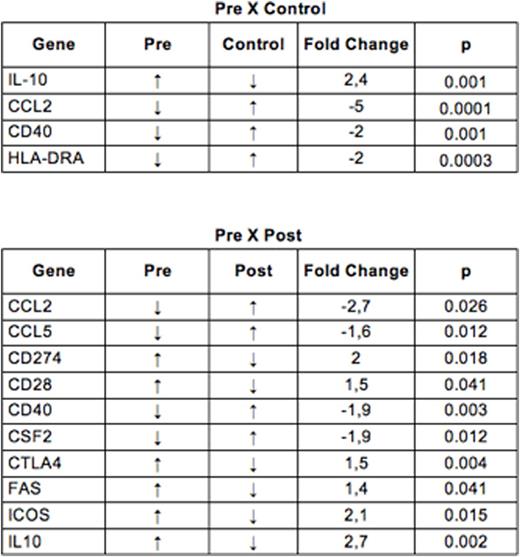Abstract
Introduction: Although immunosuppression has long been recognized in classical Hodgkin lymphoma (cHL), the underlying basis for this lack of an effective immune response against tumor remains unclear. Recently, our group showed increased frequencies levels of pro and anti-inflammatory cytokines, such as interleukins IL-6, IL-10, TNF-alpha and sCD25 in cHL patients and the impact of treatment on these cytokines. These cytokines participate in the Hodgkin and Reed-Sternberg (HRS) cells survival and immunological escape.
Objectives: In this study we aimed to evaluate the immune gene expression profile in cHL patients at diagnosis and the impact of treatment on this profile.
Patient and Methods: This is an open multicenter study and, so far, we included 51 patients consecutively from February 2011 to November 2015. Twenty consecutively diagnosed cHL patients, with whole blood RNA extracted at diagnosis and after treatment, were recruited for this study and prospectively evaluated. The general expression of 96 messengers RNAs present in the peripheral blood and involved in immune response was performed by a customized quantitative real-time PCR array (TaqMan¨Low Density Array). We also included 7 healthy controls. The data was normalized with B2M mRNAs levels and relative gene expression was calculated by the 2^DDCt method, considering Wilcoxon test and Benjamini-Hochberg adjustment to correct p-values. In this study, only cHL patients whose histology could be confirmed were studied. All patients were HIV negative and received ABVD chemotherapy protocol and radiotherapy if necessary.
Results: From the 20 patients included for this study, 12 (60%) were male, 5 (31%) had Epstein Barr virus related cHL, 18 (90%) patients presented with B symptoms, 19 (95%) patients had advanced diseases at diagnosis (stage IIBX, III and IV) and 10% of patients relapsed. Results of immune gene expression profile in patients before (pre) treatment, after (post) treatment and healthy subjects (controls) are summarized in the following table:
We observed that 4 mRNAs were altered in cHL patients before therapy (IL-10, CCL2, CD40 and HLA-DRA). After treatment, gene expression profile was similar to healthy controls. When we considered paired samples from 15 patients, 10 mRNAs were differently expressed after therapy, although the adjusted p value showed no different expression. We found no association between clinical and epidemiological characteristics with immune gene expression profile.
Conclusions: In this study we showed that, in comparison with healthy donors, cHL patients presented higher expression of inflammatory genes in peripheral blood at diagnosis. After treatment, gene expression profile was comparable to healthy controls. Furthermore, treatment seems to restore a more effective immune response; particularly, IL-10, CD274 (PD-L1) and CTLA4 which were downregulated after therapy. Understanding cHL associated immunosuppression and the immune reconstitution after treatment maybe the key to develop new prognostic factors and treatment strategies.
No relevant conflicts of interest to declare.
Author notes
Asterisk with author names denotes non-ASH members.


This feature is available to Subscribers Only
Sign In or Create an Account Close Modal